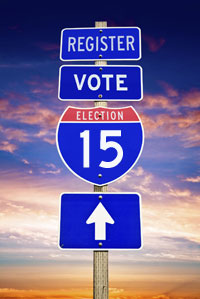All polling locations must be physically accessible for people with disabilities, and each polling location must have one accessible voting machine. But does accessibility only mean technology and brick and mortar?
Time to Change Attitudes
When we think about barriers for voters with disabilities, we often think of physical barriers, but there are people barriers, too. These challenges can be even more daunting.
“The accessible entrance was locked when I took my son to vote for the first time. I carried him in his wheelchair down the stairs.”
‒ A Mother in Cincinnati
Examples of real-life situations that could happen to voters with disabilities:
- What if the poll worker doesn’t know American Sign Language, or it takes an hour or more to get an interpreter—if one is even available?
- What if the poll worker doesn’t know how to operate the ADA-accessible machine?
- What if voting outreach and information, like candidate forums or flyers, are not accessible to people who have physical disabilities, people who are blind or have low vision, people who are deaf or hard of hearing, or people who have intellectual disabilities?
Full voting accessibility is not just checking a box on a required form or counting parking spaces; it’s a culture change that requires looking at your forms, outreach, polling locations, voting machines, instructional videos, and poll worker education. This isn’t just a service Ohio counties are providing, it’s the law.
The Americans with Disabilities Act turned 25 this year. Inaccessible polling locations should not be tolerated 25 years later.
Watch "Online For All: Helping People with Diabilities Register To Vote."
Let Me Vote
If you or someone you know has a disability, please visit the ACLU Vote Center and share the information with others. Check out helpful resources, such as frequently asked questions about voting with a disability, how to register to vote, important voting dates to remember, a step-by-step guide to voting in the state, ASL videos on voting, and who to contact if having trouble voting.
About
20 percent of people in the United States have a disability. Everyone has the right to vote free of any barriers. The ACLU of Ohio fights for this right.

